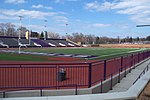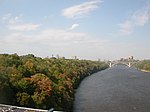St. Thomas Observatory
American astronomical observatory stubsAstronomical observatories in MinnesotaSaint Paul, Minnesota stubsUniversity of St. Thomas (Minnesota)

The St. Thomas Observatory is an astronomical observatory operated by the Department of Physics on the main campus of the University of St. Thomas in Minnesota. The observatory consists of an automated dome and a fully robotic 17-inch (0.43 m) corrected Dall-Kirkham reflecting telescope coupled with a 10.7-megapixel CCD camera. The observatory is used for public observing events and facilitates student research projects.
Excerpt from the Wikipedia article St. Thomas Observatory (License: CC BY-SA 3.0, Authors, Images).St. Thomas Observatory
Cretin Avenue South, Saint Paul Macalester - Groveland
Geographical coordinates (GPS) Address Nearby Places Show on map
Geographical coordinates (GPS)
| Latitude | Longitude |
|---|---|
| N 44.939277777778 ° | E -93.193555555556 ° |
Address
Anderson Parking Ramp
Cretin Avenue South
55104 Saint Paul, Macalester - Groveland
Minnesota, United States
Open on Google Maps








